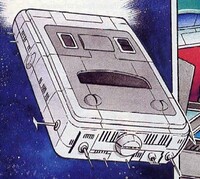Super Nintendo Entertainment System: Difference between revisions
Vellidragon (talk | contribs) m (Context and infobox disagree with those dates.) |
No edit summary |
||
| Line 57: | Line 57: | ||
*The SNES is used as the setting for the [[microgame]] "[[Super Nostalgic Entertainment System]]" in ''[[WarioWare: Smooth Moves]]''. | *The SNES is used as the setting for the [[microgame]] "[[Super Nostalgic Entertainment System]]" in ''[[WarioWare: Smooth Moves]]''. | ||
==Game Gallery== | ==Gallery== | ||
===Game Gallery=== | |||
''<center><gallery> | ''<center><gallery> | ||
Image:DKC.jpg|<center>''[[Donkey Kong Country]] | Image:DKC.jpg|<center>''[[Donkey Kong Country]] | ||
| Line 80: | Line 81: | ||
Image:Yoshi'sCookieSNES.jpg|<center>''[[Yoshi's Cookie]] | Image:Yoshi'sCookieSNES.jpg|<center>''[[Yoshi's Cookie]] | ||
Image:Yoshi'sSafariBox.png|<center>''[[Yoshi's Safari]] | Image:Yoshi'sSafariBox.png|<center>''[[Yoshi's Safari]] | ||
</gallery></center> | |||
<center><gallery> | |||
Image:Zsnes.png|<center> ZSNES, an emulator. | |||
</gallery></center> | </gallery></center> | ||
Revision as of 16:23, November 27, 2010
Template:System-Infobox The Super Nintendo Entertainment System (abbreviated to SNES, Super NES or Super Nintendo, Japanese: Super Famicom) is a video game console created by Nintendo. It was the successor to the original Nintendo Entertainment System and rivaled in performance to the Sega Mega Drive/Genesis. It had many popular games, including Super Mario World, Super Mario All-Stars and Super Mario World 2: Yoshi's Island. Other, less popular titles are Super Mario RPG: Legend of the Seven Stars and Mario Paint.
The Super Famicom was released in Japan on November 21, 1990. The Super Nintendo Entertainment System was released in America on August 13, 1991, and later in Europe in April, 1992, in Australia in July, 1992. They were discontinued in 1999. the Famicom model was discontinued in 2003. The games were discontinued in 2000. It remained popular throughout the 32/64 bit era. The SNES sold 49.10 million units durng its lifetime. There was also an add-on planned for it called the SNES CD. Nintendo worked with Sony to create this to rival against Sega CD. Nintendo's cooperations with Sony crumbled so the SNES CD was moved to Philips for a short time. The project resulted in the CD-i.
The SNES was re-released as the SNES 2, being released at the same time and had the same RF chip to the Nintendo 64. Also it was smaller and lacked the eject button.
During the SNES era, Nintendo and Sega were at the peak of their rivalry, so in many of the Mario games there were elements that mocked Sonic the Hedgehog and vice versa.
SNES Mouse
The SNES Mouse was an accessory for certain SNES games. It was compatible only with the SNES and was thus only used in the early-to-mid-1990's. The SNES Mouse mimics the appearance and action of an actual computer mouse; the SNES Mouse controlled the Stripe Pointer in some Mario games.
The SNES Mouse was originally bundled with Mario Paint and a mouse pad for $59.95.
Mario Games Compatible With the SNES Mouse
- Mario Paint
- Mario & Wario
- Mario's Early Years! Fun with Letters
- Mario's Early Years! Fun with Numbers
- Mario's Early Years! Preschool Fun
Super Famicom
| File:Super Nintendo Entertainment System-USA.jpg | 
|

| |
| Original Japanese version. | Original North American version. | Original PAL version. | The Super Famicom Jr. |
The SNES was based on a Japanese console called the Super Famicom. Famicom was a portmanteau of Family and Computer. There are obvious performance and aesthetic differences between the two consoles. It was re-released as a Super Famicom Jr., matching a USA SNES 2, but obviously, with the same differences as the SNES 1 and Super Famicom had.
Appearances in the Mario Series
A spaceship shaped like (the PAL version of) the SNES appeared in the 1997 Club Nintendo comic, "Die Jagd nach dem Nintendo 64: Krawall im All". It was used as a metaphor, referring to the discontinuation of the console, and the launch of the Nintendo 64. In the comic, Mario and Luigi traveled with this spaceship, in search for a new one. During their quest they had to compete against Wario and Bowser who chased after the new spaceship as well. At the end of the comic, the spacecraft turned out to be the Nintendo 64 and the plumbers went on to take possession of it (abandoning the SNES-spaceship), being hailed by several of their friends.
See Also
- Super Game Boy, which makes it possible to play Game Boy games on the SNES.
Trivia
- The PAL SNES (pictured) is a mix between the Super Famicom and the USA SNES, keeping the design of the Super Famicom, but keeping the name from the USA version.
- The SNES is used as the setting for the microgame "Super Nostalgic Entertainment System" in WarioWare: Smooth Moves.
Gallery
Game Gallery
- DKC.jpg
- ENTIRE warioMario box.JPG
- SMK BoxCover2.jpg
- 250px-Super mario world box.jpg
- TAT.jpg
- WWOODSbox.JPG
- Zsnes.png
ZSNES, an emulator.















